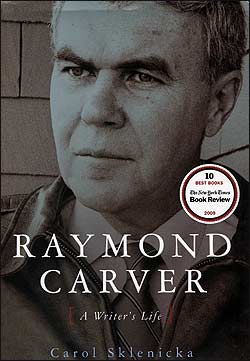
Reinvention, Resurrection
Ray Carver in life, work and drink
by Suzi Steffen
At one point in the meticulously researched, compellingly narrated and surprisingly moving Raymond Carver: A Writer’s Life (Scribner, 2009; $35), author Carol Sklenicka writes about the way Carver’s prose turned young fiction writers into copycats. New Yorker editor Charles McGrath says, “The proof of Carver’s brilliance was the difference between what he did and what all his imitators did.”
 |
Carver still occasioned something nearing awe at the Iowa Writers’ Workshop in the late ’90s, the students telling stories about his (and other writers’) legendary drinking exploits. Maybe the fashion’s changed; maybe, though, with Sklenicka’s book, students will look more carefully at the stories that Carver wrote for the legendary short story collection What We Talk About When We Talk About Love — that is, the stories he wrote before editor, enabler, rewriter, slasher, hero/villain Gordon Lish got ahold of them.
What We Talk About has long been considered the high (or low, depending on your attitude toward short stories) point of minimalist writing, with stories — some of which had been published in longer form before the book came out — featuring nameless characters, little description and grindingly sudden, bleak denouements. Sklenicka, a careful and thorough researcher and a poet with a feel for Carver’s poetry and prose rhythms, says that when Carver saw Lish’s edits on the stories for the book he “was shocked. He had urged Lish to take a pencil to the stories. He had not expected him to take a meat cleaver to them.”
Because Carver was, by then, a recovering alcoholic, and because Lish had been his editor during his down-and-out bankrupt years (a time Sklenicka paints in detail, including everything from a grad student buying a special bottle of vodka for Carver at every party to the way he and his first wife lived on the edge of ruin for years), Sklenicka theorizes that Carver was probably afraid to push back too hard on Lish’s edits. “Carver may have doubted his own authorship,” she writes, at least of these stories.
The revelation of Carver’s line-by-line comparisons of the originals to the edits and his pain over the story changes isn’t new; Carver’s second wife, poet Tess Gallagher, wrote about Lish’s high-handed edits soon after Carver died in 1988. But Sklenicka’s marshalling of constant detail and her easy familiarity with every bit of Carver’s life and work gives this discussion a force that has almost fully recast Lish from heroic discoverer of Carver to a near-butcher of his work. Of course, writers need editing and need good editors; Lish himself said that he was interested in the final work. “Which has the greater value?” Sklenicka quotes him saying. “The document as it issues from the writer or the thing of beauty that was made? What remains is an artifact of power.”
The detailed discussion of What We Talk About forms only a portion of this thorough book, a pleasure to read though the subject matter — Carver’s family history and his young life in the West (born in Clatskanie, Ore., he grew up in Yakima), his alcoholism (it saturates his life almost from beginning to end), his pretty horrific treatment of his first wife and kids, the success and relief he found in quitting and in his life with Tess Gallagher — couldn’t be less likely to evoke joy.
Sklenicka uses interviews with numerous living writers and editors, including another born-in-Oregon fiction and nonfiction giant, Bill Kittredge, a gazillion secondary sources and as much primary material as possible in this brilliantly written, authoritative biography. At almost 500 pages of text (and 50 more of appendices and notes), Raymond Carver practically mocks the spare prose of Carver’s best-known stories. Despite its length and heft, however, the work reads quickly. Sklenicka writes generously and perceptively about the Pacific Northwest, writing, alcoholism and editing. The New York Times named this work one of the 10 best of 2009, and that’s absolutely justified.
The tale of Carver’s redemption ends sourly with his death at a young age and with legal tangles after his death, but his reputation continues to morph with each new generation of young writers learning from those who went before. For writers from working-class backgrounds, he’s a touchstone; for more florid writers, he’s a foil. For the rest of us, thanks to Sklenicka, he’s a man of great talents and towering troubles whose life story balances the inspirational with the cautionary. And after reading the biography, those who have dismissed Carver out of impatience with bleakness may reconsider and rediscover his work.
Carol Sklenicka reads from Raymond Carver at 7 pm Friday, Feb. 5, at Tsunami Books (2585 Willamette). Free.